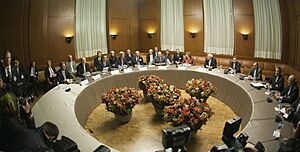P5+1 facts for kids


The P5+1 is a group of six powerful countries that worked together on a big diplomatic effort. This group includes the five permanent members of the UN Security Council (the P5): China, France, Russia, the United Kingdom, and the United States. The "plus 1" is Germany. European countries sometimes call this group the E3+3. In 2006, these countries joined forces to talk with Iran about its nuclear program. Their goal was to make sure Iran's nuclear activities were peaceful.
Contents
Why the P5+1 Formed
In 2006, the P5+1 group came together to offer Iran a new plan for talks. Before this, three European countries (France, Germany, and the UK, known as the EU-3) had been talking with Iran since 2003. China, Russia, and the United States then joined them to make a stronger group.
The UN Security Council is a powerful part of the United Nations. It can make decisions that countries must follow. The Security Council passed several official statements, called resolutions, about Iran's nuclear program.
- The first resolution, passed in July 2006, asked Iran to stop activities like enriching uranium. Uranium enrichment is a process that can create fuel for nuclear power plants, but also material for nuclear weapons.
- Over the next few years, more resolutions were passed. These resolutions put gradual sanctions (economic penalties) on Iranian people and groups. These sanctions were aimed at those believed to be involved in Iran's nuclear and missile programs.
- Another resolution in September 2008 repeated the earlier demands but did not add new sanctions.
- The last Security Council resolution, passed in June 2010, added even more sanctions. This was because Iran continued its uranium enrichment activities and did not cooperate fully.
Early Agreements and Talks (2013)
In February 2013, Iran and the P5+1 held talks in Kazakhstan. They agreed to meet again to continue discussions. Later, in October 2013, Iran suggested it might allow surprise visits to its nuclear sites. This was part of a plan to solve disagreements with Western countries. Iran also hinted that it might reduce its uranium enrichment levels.
On November 24, 2013, the P5+1 and Iran reached an important interim agreement in Geneva, Switzerland. This agreement was a temporary deal. It meant Iran would pause or partly roll back some of its nuclear activities for six months. In return, some economic sanctions on Iran would be reduced. This was a big step, as it was the first formal agreement between the United States and Iran in many years. The goal was to work towards a long-term agreement.
Working Towards a Full Deal (2014)
In early 2014, talks continued to try and reach a full, lasting agreement. A U.S. negotiator said that Iran's ballistic missile program would be part of the discussions. Ballistic missiles are rockets that can carry warheads.
However, Iran stated that its defense-related issues, including its missile program, were "red lines" and would not be discussed. Despite this, officials from the P5+1 and Iran met in Vienna in February 2014. They agreed on a plan for future negotiations. They planned to meet every month to try and create a final, comprehensive deal.
Some experts debated what a good agreement should include. Some thought it should focus on increasing "transparency," meaning Iran would be more open about its nuclear program. Others believed it also needed to make it harder for Iran to quickly develop nuclear weapons.
Final Negotiations and Agreement (2015)
The talks continued into 2015. These discussions aimed to find final solutions and reach a complete agreement. These negotiations led to the Joint Comprehensive Plan of Action, often called the Iran nuclear deal, which was agreed upon in July 2015.
See also
- Iran and weapons of mass destruction
- List of Middle East peace proposals
- Iran–United States relations
- Iran–European Union relations
- Germany–Iran relations
- Iran–France relations
- Iran–United Kingdom relations
- Iran–Russia relations
- Iran–China relations
- Joint Comprehensive Plan of Action
- Six-party talks


